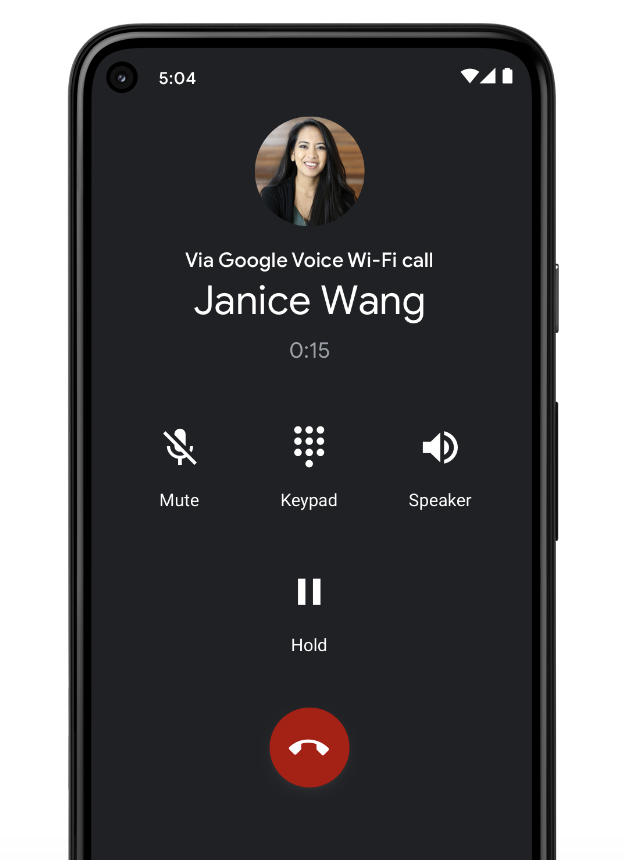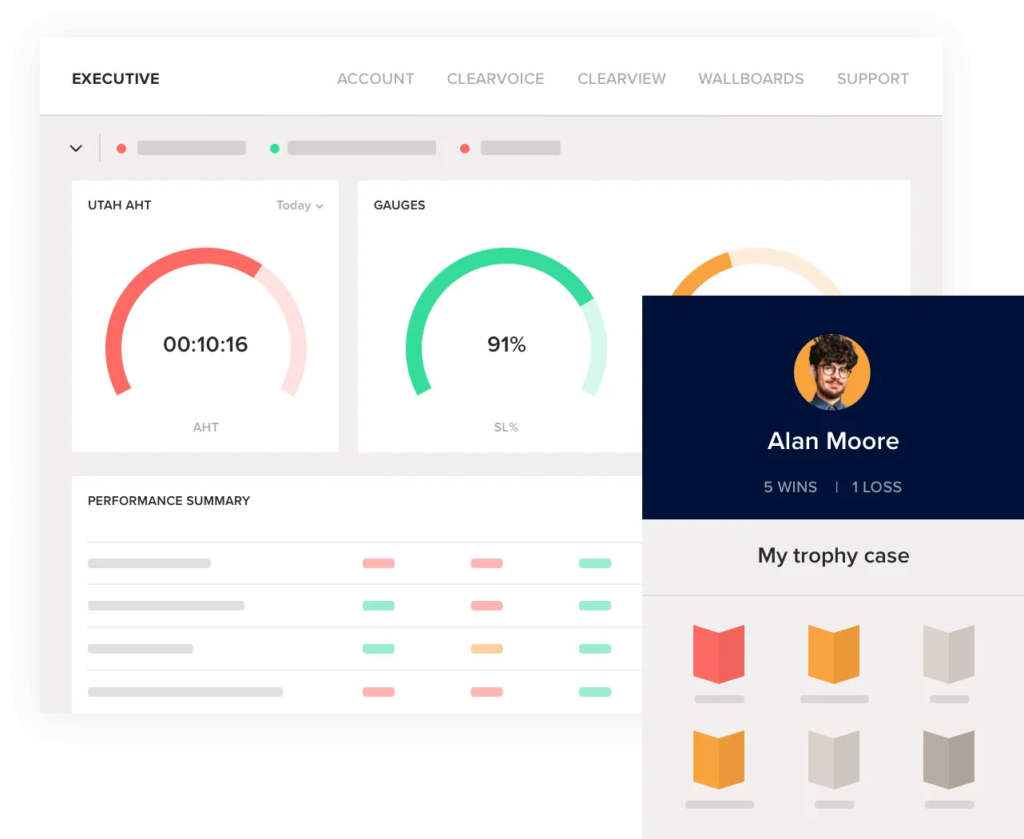Key takeaways
If you’re interested in cloud-based voice-over-internet-protocol (VoIP) solutions like Google Voice and RingCentral, delve into our comparison of VoIP vs landline systems. In this article, we weigh the costs, flexibility, and features to determine the best fit for your needs.
In this article…
Google Voice vs RingCentral: How are they different?
table, th, td {
border:1px solid black;
}
th, td {
padding: 5px;
}
| Google Voice | RingCentral | |
| Pricing (per user, monthly) | Starts at $10 | Starts at $30 |
| Features | Basic call management and productivity tools | Robust and customizable phone system |
| Integration | Google Workspace apps | Over 300 apps |
| Video Conferencing | Through Google Meet | Native feature |
| Ease of Use | Straightforward and easy to use | Intuitive with advanced functionality |
| Learn More | Visit Google voice | Visit RingCentral |
What is Google Voice?
Google Voice is a VoIP phone solution offering essential call and messaging features like unlimited texting and ring groups. This user-friendly, affordable phone system comes with a free business phone number and works seamlessly on smartphones, landlines, and web browsers.
If your team is already using Google Workspace, adding Google Voice quickly expands the tools of your productivity toolkit. All Google Voice plans come with Google integrations, including Google Meet and Calendar. As a VoIP service, it operates smoothly as long as users are connected to the internet, enabling functions such as calls, messaging, and advanced features like call recording.
Still, Google Voice does not offer toll-free numbers, which you may need if your business caters to geographically dispersed teams or clientele beyond your local area. While the platform gives users a distinct phone number, remember that you can only link Google Voice with a number through a U.S.-based carrier.
Some of Google Voice’s key features include:
Given its free version and low-cost business plans, Google Voice is one of the most practical options for solopreneurs and freelancers. All plans come with unlimited domestic and Google Voice-to-Google Voice calls, unmetered texting within the U.S., and usage and activity reporting.
There are stark differences between RingCentral and Google Voice, particularly with integration and video conferencing capabilities. Google Voice’s integration is limited to the Google ecosystem and accommodates up to 500 video participants.
Explore Google Voice’s application programming interfaces (APIs) and third-party integrations (like Zapier) to connect it to other business apps. On the other hand, RingCentral integrates with 300-plus applications and allows up to 200 video conferencing participants.

Pros
Cons
Learn more about Google Voice in our video overview.
[embedded content]
What is RingCentral?
RingCentral, a leading provider of cloud-based phone systems, offers comprehensive solutions for calls, texts, faxes, messaging, and video communications. Its feature-rich packages include artificial intelligence (AI)-enhanced video captions, analytics, and robust third-party integrations. Growing businesses seeking to streamline their communications find RingCentral highly beneficial.
This solution is suitable for people of all skill levels. Its array of advanced call management features, such as answering rules, call screening, and call logs, enable teams to customize the caller experience. Internally, RingCentral can be used as a centralized workspace for file sharing, video meetings, and instant messaging.
On the downside, RingCentral’s feature-packed offering, which includes artificial intelligence (AI) and automation solutions, might be too advanced for startups and teams with basic phone needs. This means teams will pay for features beyond what they need and use, such as automation, AI, and advanced calling features.
Some of RingCentral’s key features include:
When comparing Google Voice vs RingCentral, the latter is best if you seek advanced features and collaboration capabilities. Google Voice’s productivity tools are mainly through Workspace collaboration apps like Google Meet, Drive, and Chat. RingCentral’s messaging, conferencing, and chat features don’t require integration.
Moreover, unlike Google Voice, RingCentral offers up to 10,000 toll-free minutes, allowing callers outside your area to reach you without long-distance charges. RingCentral also comes with call monitoring features, which Google Voice lacks, for whispering to employees, entering conversations, and taking over calls.

Pros
Cons
Learn more about RingCentral in the video below:
[embedded content]
Google Voice vs RingCentral: A detailed comparison
table, th, td {
border:1px solid black;
}
th, td {
padding: 5px;
}
| Google Voice | RingCentral | |
| Free plan | ? | ? 14-day free trial |
| Unmetered domestic calling | ? | ? |
| International calling | ? | ? |
| Unlimited text messaging | ? Within the U.S. | ? |
| Toll-free minutes | ? | ? |
| Video conferencing | ? Through Google Meet | ? |
| Team messaging | ? Through Google Chat | ? |
| External integrations | ? | ? |
| Uptime guarantee | 99.9% | 99.999% |
| Multi-level auto-attendant | ? | ? With interactive voice response |
| Voicemail transcription | ? | ? |
| Customer support | Help center, community forum | Unlimited chat and phone support for Premier plans and above |
Pricing comparison: Google Voice vs RingCentral
Comparing Google Voice vs RingCentral’s plans, Google Voice offers a free personal plan and three paid plans starting at $10 per user, paid monthly. RingCentral offers four plans starting at $30 per user, monthly, and provides a 14-day free trial. Google Voice has a free personal plan and low-cost packages, making it a cost-effective option. RingCentral offers extensive features, including call management and collaboration tools. This is ideal for accommodating a growing business’ expanding requirements.
Google Voice’s pricing plans appeal to those who require basic VoIP features. Its three plan options are as follows:
- Starter ($10 per user): 10-user ceiling, unlimited calling, and messaging within the U.S., voicemail transcription, Google integrations, call forwarding, and usage and activity reporting
- Standard ($20 per user): Unlimited users, unmetered domestic and regional location, session initiation protocol (SIP) link, multi-level auto-attendant, and ring groups
- Premier ($30 per user): Adds advanced reporting (BigQuery) and automatic ad-hoc user call recording
Compared to Google Voice, RingCentral has a higher price tag, which is justified by its robust feature set and powerful customization capabilities. The three RingEX packages are as follows:
- Core ($30 per user): Unlimited domestic calling, 100 toll-free minutes, 25 business SMS per user, basic call queues, on-demand call recording, up to 100 video participants, and team messaging
- Advanced ($35 per user): 1,000 toll-free minutes, 100 business SMS per user, advanced call monitoring (whisper, barge, and monitor), unlimited internet fax, and custom roles and permissions, and adoption and business analytics
- Ultra ($45 per user): Up to 200 video participants, unlimited storage, and device analytics and alerts
Winner: Google Voice. Here’s why:
Google Voice is the better option in terms of pricing because it offers a free tier for personal use with basic features like calling and messaging. Google Voice’s paid plans are generally more affordable than RingCentral’s business plans, making it a cost-effective option for solopreneurs and businesses looking for a no-frills solution. However, RingCentral offers more advanced features and scalability options for larger organizations, which can justify its higher price point for some users.
Choosing Google Voice vs RingCentral for pricing depends on your needs. If your focus is on collaboration with AI-enhanced functionality, RingCentral, while more expensive, may offer better value. However, if you seek a straightforward, secure calling solution with seamless integration into Google Workspace, Google Voice is the more logical choice. With the Workspace integration, Google Voice is a unified communications (UC) platform with email, calendar, and messaging, enhancing team productivity and collaboration.
Features comparison: Google Voice vs RingCentral
Both Google Voice and RingCentral are reliable UC solutions. Google Voice provides straightforward VoIP features, including call forwarding and unlimited domestic calling. In contrast, RingCentral features a broader range of advanced tools, like call monitoring, hotdesking, and unlimited file storage.
Winner: RingCentral. Here’s why:
RingCentral offers on-demand or manual call recording on all plans, live transcriptions, and AI-enabled meeting insights on its entry-level subscription. Higher plans give users access to automatic call recording, extensive integrations, and custom roles. Comparatively, Google Voice doesn’t even offer some of these features on its highest plan.
If you’re looking for powerful internal collaboration tools, RingCentral is your best bet. Use the solution for team messaging, chat, audio conferencing, and collaborative notes. Google Voice also offers productivity tools, but mainly through Google Workspace app integrations.
Simply put, RingCentral offers various features suitable for diverse business needs. At the same time, Google Voice emphasizes simplicity and usability, providing a suite of basic features ideal for those already ensconced in Google’s ecosystem.
Integration comparison: RingCentral vs Google Voice
RingCentral is arguably one of the most integration-friendly, cloud-based platforms available. It seamlessly integrates with popular customer relationship management (CRM) and support applications, including 300-plus applications and over 6,000 other apps on Zapier. For example, the RingCentral for Salesforce integration connects your customer data with your phone system, and the click-to-call feature lets you place calls from within Salesforce, saving time and improving call efficiency.
Winner: RingCentral. Here’s why:
RingCentral is the clear winner in terms of integrations. It provides users with one of the most robust app integration ecosystems, reducing the need to switch between multiple devices and applications to accomplish daily tasks and access business functionalities.
On the other hand, Google Voice only connects with native Google apps like Calendar and Meet. For example, when you’re out of the office, you can sync your calendar and phone so calls are automatically routed to your voicemail on those dates. Unlike RingCentral, it lacks CRM and customer support integrations. For existing Google Voice users, keep in mind that you can explore Google Voice’s APIs and third-party integration platforms like Zapier as a workaround.
Video comparison: RingCentral vs Google Voice
Google Voice lacks native virtual conferencing features, but business users have access to Google Meet for online web conferencing calls and video chat. Google Meet is an enterprise-grade solution with participant limits of 100 to 500, depending on your Workspace plan. Users can host unlimited meetings for up to 24 hours. Both platforms offer high-definition (HD) video quality and interactive features like emojis and screen sharing.
Comparatively, RingCentral meetings accommodate up to 200 video participants, with an add-on option for unlimited online conferences with up to 500 participants per meeting. The base plan lets you host HD meetings for up to 50 minutes with up to 100 participants. Its notable video features include presentation mode, in-meeting chat, whiteboard, breakout rooms, and encryption. Based on experience, RingCentral excels in background noise management and has better bandwidth.
When it comes to Google Meet’s inclusions, key functionalities are live captions, polls, low-light mode, attendance tracking, and co-hosting. It’s intuitive, with all controls conveniently located at the lower portion of the screen, and its modern, clean interface minimizes clutter and user confusion.
Winner: Tie. Here’s why:
This category comparison ends in a draw because it depends on your needs. Google Meet, through Google Voice, is a reliable video platform great for smaller teams that don’t need all the conferencing bells and whistles. RingCentral’s higher price caters to those looking for a comprehensive, scalable service.
Read more: Best VoIP for Small Business 2024
Ease of use comparison: Google Voice vs RingCentral
New technology and systems often have a learning curve, and when it comes to VoIP systems, setup, analytics, and call management protocols, it might take some getting used to. Both Google Voice and RingCentral are relatively easy to use, but Google Voice is more straightforward, so there’s less to maneuver.
Winner: Google Voice: Here’s why:
Google Voice beats RingCentral in terms of ease of use because of its simplicity and setup. Google Voice has a clean interface that’s easy to navigate, particularly for those who mainly want to use this solution for texting and calling. Setup is relatively easy, as it doesn’t require any technical know-how or complex hardware or software installations.
It’s good to note that you don’t need much technical expertise or training to use either Google Voice or RingCentral. The latter offers various learning resources, like blogs and community pages, to help users navigate the software. Google Voice has a clean and simple interface and segregates your inboxes for easy access. Both have mobile applications for Android and iOS devices, enabling users to make calls, send texts, and check voicemail from their homes or while on the road.
Read more: VoIP vs Cellular: What’s the Difference?
RingCentral vs Google Voice: How to pick?
RingCentral and Google Voice are two leading business phone systems known for reliability and functionality. When choosing between providers, keep the following in mind:
- Company requirements: Consider your team’s specific features, such as the number of employees, technology, cost structure, and audience. These considerations affect your company’s operation and ability to spend and maximize your IT solution.
- Functionality: Divide features based on what you need and what would be nice to have. Consult your colleagues to learn which tools are useful and see if these features are offered “out of the box” by UC providers.
- Cost and price: Pricing often varies based on the number of seats, features, and mode of payment. Identify base features and whether you must upgrade your plan to access essential features. You must have a ballpark figure of your budget so you can make the most sustainable decision.
- Customer support: Review the support channels offered at each service tier. Support options can differ among plans and providers, typically offering fewer support avenues for lower-tier plans and expanding communication modes as you move to higher-tier plans.
In this Ring Central vs Google Voice debate, the decision will ultimately depend on your needs, budget, and preferences. RingCentral is best for businesses looking for a customizable phone system, while Google Voice is excellent for Google users needing a simple solution.
Read more: Best Free VoIP Phone Services & Software for 2024
FAQs

